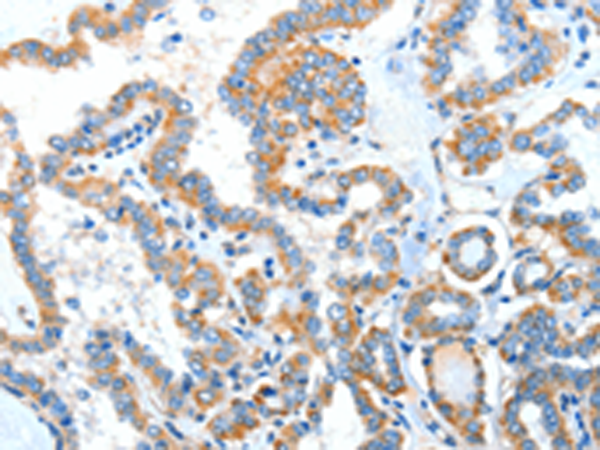

| WB | 咨询技术 | Human,Mouse,Rat |
| IF | 咨询技术 | Human,Mouse,Rat |
| IHC | IHC:1/100-1/200;IHF:1/50-1/200 | Human,Mouse,Rat |
| ICC | 1/50-1/200 | Human,Mouse,Rat |
| FCM | 1/20-1/100 | Human,Mouse,Rat |
| Elisa | 咨询技术 | Human,Mouse,Rat |
| Aliases | XBP2; TREB5; XBP-1 |
| Host/Isotype | Rabbit IgG |
| Antibody Type | Primary antibody |
| Storage | Store at 4°C short term. Aliquot and store at -20°C long term. Avoid freeze/thaw cycles. |
| Species Reactivity | Human |
| Immunogen | Fusion protein of human XBP1 |
| Formulation | Purified antibody in PBS with 0.05% sodium azide and 50% glycerol. |
+ +
以下是3篇与Anti-XLF抗体相关的文献摘要信息,涵盖其在DNA修复机制及疾病中的研究应用:
---
1. **文献名称**: *Cernunnos, a Novel Nonhomologous End-Joining Factor, Is Mutated in Human Immunodeficiency with Microcephaly*
**作者**: Revy, P. et al.
**摘要**: 本研究首次鉴定Cernunnos/XLF蛋白为非同源末端连接(NHEJ)关键因子。通过患者细胞系分析,发现XLF突变导致DNA双链断裂修复缺陷。Anti-XLF抗体被用于Western blot和免疫荧光,证实突变体蛋白表达缺失及细胞核定位异常,揭示了XLF在免疫系统发育中的核心作用。
---
2. **文献名称**: *XLF Interacts with the XRCC4-DNA Ligase IV Complex to Promote DNA Nonhomologous End-Joining*
**作者**: Ahnesorg, P. et al.
**摘要**: 该研究通过免疫共沉淀(使用Anti-XLF抗体)及结构分析,证明XLF与XRCC4-Ligase IV复合物直接结合,增强DNA末端连接活性。实验表明,XLF缺陷细胞对电离辐射敏感,补充野生型XLF可恢复修复能力,提示其在维持基因组稳定性中的功能。
---
3. **文献名称**: *Structural and Functional Insights into the Role of XLF in DNA Repair*
**作者**: Ochi, T. et al.
**摘要**: 本研究利用冷冻电镜解析XLF与DNA及XRCC4的复合物结构。Anti-XLF抗体被用于蛋白纯化验证及细胞定位实验,揭示了XLF通过促进DNA桥接和招募其他修复因子的分子机制,为靶向NHEJ的癌症治疗提供理论依据。
---
**注**:上述文献年份集中于2006-2015年,涉及XLF的功能验证、相互作用及结构研究。如需具体DOI或补充文献,建议通过PubMed搜索关键词“XLF antibody”或“Cernunnos XLF”获取最新进展。
Anti-XLF antibody is a research tool used to detect XLF (XRCC4-like factor), also known as Cernunnos, a critical protein involved in DNA double-strand break (DSB) repair. XLF plays a key role in the non-homologous end joining (NHEJ) pathway, a major mechanism for repairing DSBs in mammalian cells. It interacts with XRCC4 and DNA Ligase IV (Lig4) to stabilize the repair complex, facilitating DNA ligation. XLF deficiency is linked to genomic instability, immunodeficiency, and developmental defects, underscoring its importance in maintaining genome integrity.
Anti-XLF antibodies are widely used in molecular biology and clinical research to study NHEJ mechanisms, particularly in contexts like cancer (where DSB repair dysregulation is common) and immune system development (via V(D)J recombination). These antibodies enable detection of XLF expression levels, localization, and interactions through techniques like Western blotting, immunofluorescence, and immunoprecipitation. They also serve as biomarkers in diagnosing XLF-related disorders, such as microcephaly or radiation-sensitive severe combined immunodeficiency (RS-SCID). Commercial Anti-XLF antibodies are typically validated for specificity, often targeting conserved regions of the protein (e.g., human XLF’s C-terminal domain), and are essential for advancing studies on DNA repair pathways and therapeutic targeting of genomic instability diseases.
×